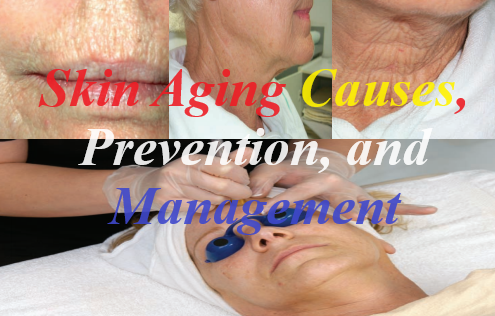Skin Aging Causes, Prevention and Management

Skin Aging Causes, Prevention and Management
What are the causes of skin aging?
Here we discuss several factors that influence aging.
Gravity is certainly a factor.
The gravity of the earth constantly pulls on our bodies, including the facial skin.
This gravity is one factor that causes skin and muscle to sag.
Lack of oestrogen after menopause diminishes the production of collagen, causing sudden changes in the skin and resulting in more skin laxity, wrinkles, and dryness.
Even an individual who takes immaculate care of both skin and body will have some sagging of the face over a period of years.
Even people who have never exposed their faces to the sun will have some sagging.
This sagging is referred to clinically as elastosis, which means “loss of elasticity.”
Ptosis (TOE-sis) refers to more specific areas of drooping skin, such as eyelid ptosis or breast ptosis.
Although facial treatments and state-of-the-art products can help prevent and treat elastosis to some degree, the appearance of severely sagging skin can be corrected on a long-term basis by plastic surgery.
Let’s look at an example of elastosis.
If you purchase a new pair of underwear, it has an elastic waistband. If you wear this underwear many, many times, the elastic begins to wear out.
At some point, the elastic waistband no longer “snaps back” the way it did when the underwear was brand new.
Skin is the same way; aging causes a wearing down of the elastin fibrils in the dermis that gives skin its elasticity.
If you pinch the skin of a 50-year-old person’s cheek, it does not snap back as fast as that of a 20-year-old.
Cumulative effects of glycation can be a factor in wrinkles and elasticity as well.
Gravity also causes the nose to droop downward and the ears to become larger over a period of years.
In addition, cartilage in both the nose and ears can grow after age 40, making the nose and ears larger.
Individual bone structure plays a role in intrinsic aging.
As elastosis occurs, facial bone structure can affect how the facial features appear.
Someone with a strong, prominent jawbone may appear younger than someone with a less prominent jawbone.
High cheekbones are also a good facial feature (due to genetic bone structure) that can soften the appearance of cheek elastosis.
Expression Lines
Expression lines are another symptom of intrinsic aging.
Individuals develop lines from their unique consistent and repetitive facial movements.
“Smile” lines occur in the nasolabial area.
“Frown” lines may also occur in the forehead, eye, and chin areas.
Any repetitive movement of a facial expression such as raising the eyebrows, frowning, smiling, scowling, or any other facial movement eventually causes a crease to occur, just like pants get more wrinkled the more you wear them.
“Eye smilers” smile and squint at the same time, creating additional eye lines.
Squint lines also occur around the eyes from squinting due to sun exposure, light exposure, or facial expression.
It is important to wear ultraviolet protective sunglasses while outside to provide protection against both ultraviolet light exposure and the tendency to squint when exposed to light.
Smokers often get “smoker’s lines” around the mouth and eyes from continually moving these areas during smoking activities.
Smoking also causes thousands of free radicals to invade the body and is known to interfere with proper collagen production.
Many women who never smoked also get what appear to be smoker’s lines around the mouth.
This is obviously not caused by smoking, if the woman never smoked.
Men generally do not get these multiple lines around the mouth.
Although it is not confirmed what causes these lines in nonsmokers, it most likely is caused by a hormonal factor or a physiological genetic factor in females.
Sleep habits, such as sleeping on one side or directly on the face, will eventually create lines and elasticity problems.
Advise clients to sleep on their backs as much as possible, thus helping to avoid “sleep creases” that when they happen repetitively have a strong effect on the aging symptoms of the face.
The “Wearing Out” of the basics
As time progresses, the muscles, fat, and skin on our faces undergo structural changes.
The amount of fat in the subcutaneous layer decreases with age, providing less cushion and plumpness to the skin, resulting in less support.
People who are overweight often do not have as many noticeable wrinkles on their faces as thin people or people of normal weight.
This does not mean that the skin has not aged; it simply means there is more fat to “plump out” the skin, making it smoother looking.
The skin is stretched back and forth over a lifetime, causing an “enlargement” of the skin, and gravity pulls down on the skin.
The muscles have partially receded, causing the effect of more elastosis.
Slowing of Cell Renewal
As the skin ages, the cell renewal cycle within the skin slows down.
Therefore, the production of intercellular lipids decreases, which in turn decreases the skin’s ability to hold water and thus decreases barrier function.
This is dehydration, and it results in dull, rough-textured skin that feels dry.
This lack of moisture can make wrinkles and elastosis look much worse.
The lack of lipids in the barrier function also can result in increased sensitivity in older skin.
The lipids in the normal barrier prevent the penetration of irritants.
When the barrier is compromised, irritants may penetrate and cause inflammation, which can cause redness and discomfort as well as lead to biochemical aging effects on the skin structure.
Several techniques will help slow the cell renewal cycle and the decrease in lipid production:
- Using proper protective moisturizers and sunscreen on a daily basis will guard the barrier function and intercellular lipids. Products that contain protective emollients such as silicones, petrolatum, or natural emollients help preserve the barrier function. Avoidance of stripping detergent cleansers also helps preserve the barrier lipids and function. As a general rule, if the skin feels tight after cleansing, the cleanser is too strong for that particular skin.
- Use of lipid replacement ingredients can help supplement and “patch” the inter-cellular barrier lipids. Lipid ingredient complexes combining ceramides, cholesterol, phospholipids, and fatty acids can be used in sunscreens, hydrators, specialty creams and serums, eye and neck products, and masks, and they can be blended with antioxidants and peptides.
- Regular daily use of an alpha hydroxy acid serum, lotion, or cream has been documented to improve the look of the skin surface. AHAs also boost cell renewal and improve barrier function by promoting intercellular lipid production.
Hormonal Factors in Aging
During menopause, in a woman’s 40s and 50s, the ovaries dramatically reduce the secretion of the female hormone oestrogen.
Oestrogen is required to stimulate the production of collagen in women’s skin.
This sudden lack of oestrogen causes less collagen to be produced and results in thinner skin, dryness and dehydration, more wrinkling, and skin laxity or elastosis.
If the skin is also sun damaged, the symptoms are even worse.
Wrinkles versus Sagging
Wrinkles and skin sagging are characteristics of both intrinsic and extrinsic aging.
Usually, wrinkles are seen before sagging or elastosis.
Clients usually express concern about wrinkles as early as age 30, and they express concern about sagging about 10 years later.
Wrinkles associated with intrinsic aging are primarily expression lines.
Sagging associated with intrinsic aging is relatively minor and is attributable to gravity and intrinsic physiological changes.
Criss-cross wrinkling, wrinkles not in the normal facial expression, and severe elastosis are all symptoms of sun and extrinsic damage.
Prevention and management of aging skin
Each year, ski researchers learn more and more about how to prevent aging of both the body and the skin.
One of the newest theories is that the symptoms we think of as aging are actually only an accumulation of tissue damage that has occurred over a number of years.
In other words, the signs of aging may be related more to damage of tissue than to the actual passing of the years.
Although there is really very little anyone can do to completely prevent inevitable intrinsic aging of the skin, everyone can develop certain health habits that will help delay the onset and manage the severity of intrinsic aging symptoms.
Sun Protection on a Daily Basis
Even though intrinsic aging is not caused by sun exposure, prevention of sun exposure is the biggest preventable factor in the avoidance of prematurely aging skin.
Daily use of broad-spectrum sunscreen is paramount in any skin care program.
Preventing the inflammatory reactions caused by sun exposure is bound to have positive effects on skin health in general.
Diet and Exercise
Again, good health habits do not prevent all intrinsic aging, but they help the body nourish the skin better and therefore help fight aging.
Avoiding excessive alcohol also helps the body function better.
A regular aerobic exercise program and a well-balanced, healthy diet can certainly help an individual live longer and better and promote healthy skin function.
Many scientists believe that a diet rich in antioxidant foods and the use of antioxidant supplements (vitamins C and E and grapeseed and green tea extracts) may help protect body tissues, including the skin, from free radical damage, thus reducing the signs of aging.
Smoking is known to severely affect the health and function of all cells in the body.
Smoking and exposure to second-hand smoke should be avoided for a healthy body or skin.
We learn more and more each day about nutrition and its relation to health.
Although we do not focus on nutrition in this book, many aestheticians find it helpful to receive a good nutrition education.
Although it is not the aesthetician’s role to give nutritional advice and counselling (this is the role of the physician and registered dietitian), the aesthetician should have a working knowledge of the elements of nutrition to better understand skin function and health and to refer clients with nutritional or eating disorders to the properly qualified professionals.
Weight Gain and Loss
People who are overweight have problems with skin stretching to accommodate the extra fat.
This can occur anywhere on the body, but it is especially noticeable in the face.
Extra skin below the chin and on the neck is a good example.
When people lose weight, sometimes the skin has been overstretched and does not return to its original contour.
This is especially true if the client is morbidly obese, has been overweight for a long time, or is older than 40 years of age.
Again, this symptom can occur anywhere on the body, but it is especially common in the facial skin.
Plenty of Sleep
Getting plenty of sleep is another good health habit.
The body needs time to regenerate its tissues and repair damaged cells.
Lack of sleep can cause or worsen eye circles and puffiness and contribute to stress that can have a debilitating effect on both the mind and body.
Stress
Each day, medical researchers are learning more and more about stress and its effect on health, nutrition, and aging.
Avoiding high amounts of stress certainly will help prevent premature aging signs not only of the skin but of the other organs of the body.
Many resort spas, as well as day spas, now offer stress management, yoga, and other body treatments designed to reduce and manage stress.
Massage services, aromatherapy services, and a soothing environment within the spa can help reduce daily stresses for you and your clients.
Again, although aestheticians cannot permanently change their clients’ lifestyles, they should be abreast of the newest research regarding stress and health to help give their clients the best aesthetic care possible.
Aestheticians should also be aware of referral services to qualified professionals who handle stress, such as psychologists.
Good Skin Care
More and more evidence indicate that a good skin care program helps combat and prevent the skin symptoms of even intrinsic aging.
Besides making the skin look better on a daily basis, long-term use of good skin care appears to have long-term rewards.
A good home-care program for aging skin includes these components:
- A daily-use broad-spectrum sunscreen moisturizer with an SPF of 15 or higher. This should be properly selected for the client’s skin type.
- Alpha hydroxy treatment serum with at least 8 to 10 percent AHA (usually glycolic and/or lactic acids). As previously mentioned, daily use of AHA stimulates cell renewal, improves barrier function, rehydrates the skin, and removes dead, dull surface cell buildup. It makes the skin look smoother, minimizes the appearance of wrinkles, and improves skin colour and tone. Long-term daily use of AHAs also promotes formation of new collagen. As an alternative to AHAs, your client can use retinoids including retinol and prescription tretinoin (Retin-A®, Renova®). These products are derived from vitamin A and help smooth wrinkles, improve coloration, and refi ne texture.
- Hydration is vital; clients should use both water-binding and protective ingredients appropriate for their skin type. Hydration ingredients include sodium PCA, sorbitol, glycerin, hyaluronic acid, or sodium hyaluronate. As previously discussed, lipid ingredients help support barrier function, improving skin hydration and reducing sensitivity.
- Antioxidants protect skin cells from inflammation caused by reactive oxygen radicals, preventing gradual skin structure breakdown.
-
Antiglycation agents protect against stiffening of protein fibrils, which can create and worsen wrinkles.
- Peptides are used to stimulate collagen, relax wrinkle tightness, reduce fluid retention, and decrease inflammation. They are available as serums or can be combined with hydrators and antioxidants in creams or fluids.
- Use of mechanical exfoliants at home several times a week can also help remove dead cells loosened by daily use of alpha hydroxy acids. Mechanical exfoliating ingredients include polyethylene granules, cornmeal, ground almonds, or hydrogenated jojoba oil beads. These products literally “bump off” dead cells and can diminish the look of tired or neglected skin.
- Clients should be careful, no matter what their skin types, not to over exfoliate. This can be very irritating and damaging to the skin. Aging skin may be more vulnerable to mechanical or chemical damage because it is thinner or may have impaired barrier function.
In the salon, enzymes such as;
- bromelain,
- papain,
- or pancreatin
- or professional alpha hydroxy acid exfoliation treatments,
- the use of microdermabrasion
can be used to freshen dull-looking, aging skin.








